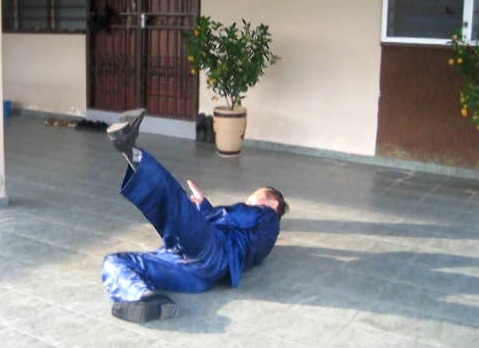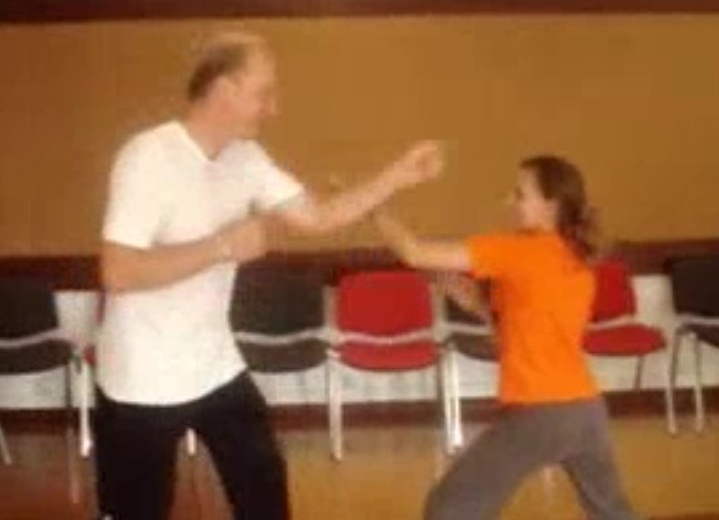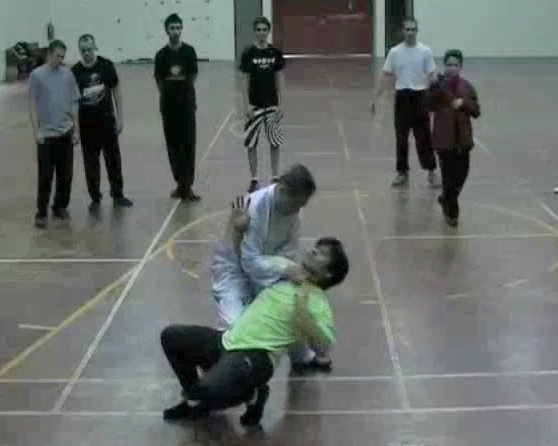WHAT IS SO SPECIAL ABOUT THE EIGHTEEN-LOHAN FIST?

18-Lohan Fist is very special because it is the prototype of Shaolin Kungfu, and all martial art techniques are found in Shaolin Kungfu! Do you realize, for example, that this Lohan Fist pattern, "Lohan Takes Afternoon Nap", is a pin-down technique?
Question
May you share with us what is so special about the 18-Lohan Fist?
How can the 18-Lohan Fist enrich my Taijiquan practice?
What would be the strengths and weaknesses of the 18-Lohan Fist?
Santiago
Answer
The two facts that the Lohan Fist is the prototype of Shaolin Kungfu, and that techniques of all other martial arts can be found in Shaolin Kungfu, make the Lohan Fist very special.
It is worth noting two common misconceptions, that Bodhidharam, despite being honoured as the First Patriarch of Shaolin Kungfu, did not invent Shaolin Kungfu, and that kungfu, or Chinese martial arts, did not start at the Shaolin Temple. Kungfu was already practiced at a high level even before the Shaolin Temple was built. Generals like Thik Cheng (who expanded the Han Empire to the West), Lu Pu (considered the most formidable in the Three Kingdom Period) and Zhao Yun (who was undefeated in all his battles, also of the Three Kingdom Period) were before the Shaolin era.
Bodhidharam taught the 18 Lohan Hands at the Shaolin Temple, and retired generals at the temple evolved these chi kung exercises into the Eighteen-Lohan Fist. Various Shaolin styles developed from the Eighteen-Lohan Fist, like Taizuquan, Taijiquan, Wuzuquan, Xingyiquan, Eagle Claw and Praying Mantis from the northern Shaolin Temple, and Hoong Ka, Wing Choon, Choy-Li-Fatt, White Crane and Dragon Style from the two southern Shaolin Temples. Amongst other benefits, knowing the Eighteen-Lohan Fist provide insight to the source and development of various kungfu styles.
It is understandable that many other martial artists may be angry at the statement that techniques of all other martial arts can be found in Shaolin Kungfu, often at a less than perfect form. I can’t remember whether this fact was mentioned before, but I discovered (or rediscovered) and confirmed it again and again in my research and study of other martial artists before sparring with them more than 30 years ago.
While their techniques could be found in Shaolin Kungfu, I was shocked at their lack of perfect form, which exposed them to easy counter attacks and which I exploited. For example, Karatekas often punched high leaving their ribs exposed, Taekwondokas had poor balance after kicking, Judokas did not attempt to cover their opponents when they executed their throws, and Boxers threw their body forward in their strikes. A well-trained kungfu practitioner would never commit all these weaknesses, which gave free offers to their opponents.
Wrestling, was regarded as a sport, and it was well known amongst kungfu circles that without safety rules, wrestlers would be dangerously exposed. Wrestlers would be killed or serous injured in a real fight with a genuine kungfu master. Kick-Boxing and Mixed Martial Arts were unknown then, but looking at these arts today we can readily see that their exponents would be dangerously exposed if not for their safety rules.
When Kai taught counters against pin-downs many years ago at a special course in Sungai Petnai, I was pleasantly surprised to see that all the attacks and counters were found in Shaolin Kungfu, though most Shaolin practitioners might be unaware of the application even when they had learnt the techniques. We all have to thank Kai for opening up this whole area of attacks and counters.
Surprisingly, Muay Thai fighters were the ones I found most guarded amongst the other martial arts, or sports. But I had the great advantage of my sifu, Sifu Ho Fatt Nam, who himself was a professional Muay Thai champion, teaching me many secrets in fighting against Muay Thai. However, when a Muay Thai fighter clinches onto you to deliver his deadly knee jabs, feared by many martial artists, he is exposed.
Amongst many other benefits, practicing Eighteen-Lohan Fist with its picture-perfect form, will enable us to avoid these weaknesses, and exploit them if our opponents expose themselves. This philosophy is also applicable in our daily life.
I would strongly recommend those who practice Taijiquan to learn Eighteen-Lohan Fist, and vice versa, because representing the two extremes of “kong” and “yau” (“kang” and “rou” in Mandarin), or literally “hard” and “soft”, and figuratively “force” and “flowing”, the two arts complement each other.

Applying the principle of "using softness to subdue hardness" in Taijiquan, a small sized person can defeat a bigger, stronger opponent
An example in daily life occurred recently in Hawaii. Simu (Sipo) and I had a memorable lunch with the Japanese group led by Emiko. When we arrived at a restaurant, a waitress directed us to a bigger round table and another smaller square table, which was not only uncomfortable but also we had to be separated into two groups. I rejected this arrangement, and told her to arrange a few square tables in a row so that we could sit more comfortably together in one group. The waitress was unwilling.
With the "force" from my Eighteen-Lohan Fist training, I asked her what was wrong with my suggestion as it could be done. I started arranging the square tables myself, and some Japanese girls were quick to help me – thanks to their excellent training under Emiko. Before the waitress could realize what had happened, the tables were arranged and we all were comfortably seated. If I had only trained Taijiquan, and used to yielding, we would be confined to sitting uncomfortably in two groups.
Of course I had to be considerate that my suggestion would not unfavorably affect the restaurant business, which was not using brutal strength, and that we would not go hungry without lunch, which was safety first. Indeed, we brought good business for the restaurant. When we first entered, the restaurant was quite empty, but by the time we finished our lunch, it was quite full. It was always like this as our good chi attracted business. The food was good too, and I made a point to compliment the restaurant workers. I also gave a big tip, which made them very happy. All these benefits are from my Taijiquan training, which enables me to have yin-yang harmony.
The strength of the Eighteen-Lohan Fist is its "hardness". It is a powerful set excellent for pressing opponents, giving them little chance to escape. However, if the opponents are skillful, especially those trained in Taijiquan, they can use "softness to subdue hardness", or “ye yau chai kong” in Chinese (Cantonese). This lack of “softness” is therefore its weakness.
The term "ye yau chai kong" is often mentioned by Taijiquan practitioners. But most of them, who are more aptly called Taiji dancers, not only do not have the skills to implement this principle, but also do not even know in theory how this principle is applied. As a rough guide, if you can apply this principle of “ye yau chai kong”, you are rightly qualified to be a Taijiquan practitioner. Our application of “Immortal Waves Sleeves” to deflect a powerful punch, using rotation of our waist, is a classic example of “using softness to subdue hardness”.
If "using softness to subdue hardness" is true, does it mean that softness will always beat hardness? No, there is a corresponding principle, "Ye kong hak yau", which means "using hardness to overwhelm softness", and which is the main principle of the Eighteen-Lohan Fist. "Ye kong hak yau" is also a guiding principle of all Shaolin styles as well as all forceful martial arts. It is not as widely mentioned as "ye yau chai kong", but is more easily understood.
When a die-hard martial artist rushes in to wildly hit a Shaolin Wahnam student and overwhelm the latter, despite the latter having better techniques but lacking in the element of threat, the former is exhibiting the principle of “using hardness to overwhelm softness”.
Whether "using hardness to overwhelm softness" or "using softness to subdue hardness" will triumph, depends on the skill of the exponents as well as their fighting experience. All other things being equal, if the “hard” exponent is more skillful than the “soft” exponent, “using hardness to overwhelm softness” will triumph, and vice versa. Similarly, all other things being equal, if the “soft” exponent has more fighting experience than the “hard” exponent,. “using softness to subdue hardness” will triumph, and vice versa.
There are many versions of Eighteen-Lohan Fist. The early versions, being at the start of kungfu development, were simple and straight-forward. The techniques were mostly punches, with a few kicks, not unlike Karate katas today. When I bought a copy of an early version of Eighteen-Lohan Fist about 45 years ago at a time when my understanding of kungfu history and philosophy were rudimentary, I was surprised at its simple techniques.
Sophisticated techniques, like chin-na of the tiger-claw and eagle-claw, dim mark of One-Finger Zen, dragon-hand and phoenix-eye, trickiness of the monkey-paw, profundity of Xingyiquan and Wuzuquan, flowing nature of Taijiquan, mobility of Baguazhang, leg techniques of Praying Mantis Kungfu, and felling techniques of Drunken Style, were developed later. Although later versions of the Eighteen-Lohan Fist incorporated some of these sophisticated techniques, on a whole the Eighteen-Lohan Fist has maintained its typical features of forceful, pressing techniques, which constituted its strength, but can also be its weakness if applied rigidly or against a skillful and knowledgeable opponent.
These weaknesses, however, are not found in our Shaolin Wahnam version of the Eighteen-Lohan Fist which we shall learn in Frankfurt. Without meaning to be presumptuous, many masters of Eighteen-Lohan Fist may not appreciate what has been discussed above, and therefore miss its significance and benefit. They may just teach the set as it has been passed down their lineage. Many of them may not even teach the combat application of basic patterns, and hardly any may relate how to apply Eighteen-Lohan Fist to enrich their daily life.
Course participants to the Eighteen-Lohan Fist course in Frankfurt will benefit from my breadth and depth in my understanding and practice of kungfu. Our version of the Eighteen-Lohan Fist will include the benefits of other styles while maintain its own nature and flavor. We shall also learn lessons at the course to enrich our daily life.

Sophisticated techniques like chin-na are later development of the 18-Lohan Fist, and therefore not found in its early versions
Little Lohan Fist
18-Lohan Fist
Treasure House of Kungfu Sets
Treasure House of Combat Application
Those who wish to attend the 18-Lohan Fist course in Frankfurt, Germany on 26th, 29th, 30th September and 1st October 2014, please contact Secretary, Wahnam Germany or phone (069) 904-31954.
The questions and answers are reproduced from the thread 10 Questions on 18-Lohan Fist in the Shaolin Wahnam Discussion Forum.
LINKS
